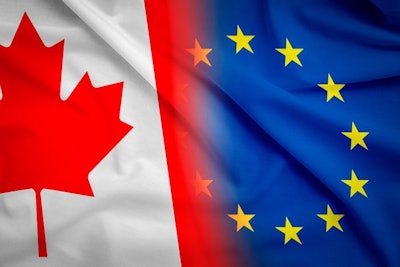
Agricultural trade was the main topic of a recent discussion between the Canadian agriculture ministry and the EU Agriculture Commissioner.
An agreement was reached between Minister Marie-Claude Bibeau and Commissioner Janusz Wojciechowski regarding the present strength of the relationship between the two parties, and the need for free and open trade.
Looking ahead, Minister Bibeau called for technical barriers to trade to be removed so that Canada can gain greater access to the EU market for agricultural and food products. This, she said, will allow Canadian farmers and processors to gain greater benefit from the Canada-European Union Comprehensive Economic and Trade Agreement (CETA), particularly following the coronavirus (COVID-19) pandemic.
More on CETA
September of 2017 saw CETA come into provisional effect, and it has led to an increase in trade between the two parties.
Comparing figures for 2016 (the last full year prior to CETA) with 2019, Canadian exports of agriculture and agri-food to the EU have increased nearly 12%, according to the Canadian agriculture ministry. Products that have most benefited from the tariff reductions have been cranberries, fruits and nuts, dog and cat food, and maple sugar and syrup.
Over the same period, other commodities that saw an increase in exports to the EU were canola seed (up 97%), soybeans (up 13%), and corn (up 11%).
Although only three years old, CETA is already delivering concrete positive results in terms of increased EU exports to Canada, according to EU Trade Commissioner Phil Hogan. Addressing the Dutch Senate recently, he said that while exports to the rest of the world had risen by 3.5%, there had been a 9% increase in trade to Canada.
Addressing the concerns that had been expressed in the EU about negative consequences of lowering trade barriers and tariffs under CETA, Hogan said that the EU had, in fact, increased its trade surplus with Canada. He reported that EU imports of Canadian agri-food products decreased by 10% since the deal was implemented.
Canadian meat exports to the EU remain at a low level, according to the Commissioner. Fill rates for Canadian pork and beef were just 1.5% and 3% respectively in 2018. In 2019, quota use rates were 0.47% for pork and 3.1% for beef. This compares to 96% for the EU cheese export quota to Canada.
Hogan stressed that not only had the EU maintained its food safety and quality standards, but Canada updated its Animal Transport Regulations in February of 2020, introducing stricter animal transportation requirements. Under CETA, all products imported into the EU must comply with European rules and regulations, including those covering hormones and GMOs.
CETA: impacts on EU-Canada meat trade
Of all meats, only pork figured among the top 20 agrifood products exported by the EU to Canada during 2019, according to the latest European Commission statistical factsheet covering trade between the two parties. Ranked 15th in terms of value, European pig meat (fresh, chilled, and frozen) to a value of EUR58 million (US$65 million) was exported to Canada in 2019. This represents a fall of 18.3% in this trade year-on-year, and compares with EUR80 million in 2017, when CETA came into effect.
As well as pork, the EU exported to Canada in 2019 modest volumes of poultry meat (EUR16 million), beef (EUR15 million), and sheep meat (EUR7 million).
In the same year, Canada exported EUR21 million in beef to the EU, but negligible quantities of poultry meat and pork.
In previous years — 2017 and 2018 — the EU imported around EUR1 million each year of Canadian pork.
Back in 2014, Canadian pork producers were looking forward to the opportunities offered by CETA. Three years later, the same group was lobbying for the removal of trade barriers that would open the way for commercially viable two-way-trade between the parties.
In 2019, total agrifood exports from Canada to the EU amounted to EUR2.044 billion, an increase of 25.6% year-on-year. The EU expanded its exports in this category to Canada by just 6% last year to EUR3.549 billion.

















